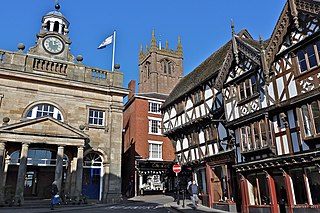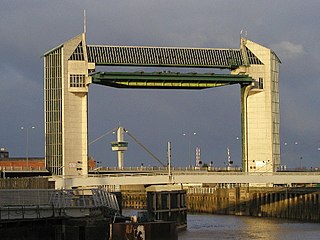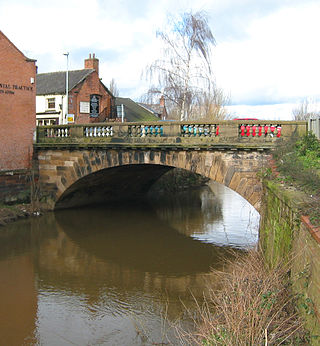Related Research Articles

Ludlow is a market town in Shropshire, England. The town is significant in the history of the Welsh Marches and in relation to Wales. It is located 28 miles (45 km) south of Shrewsbury and 23 miles (37 km) north of Hereford, on the A49 road which bypasses the town. The town is near the confluence of the rivers Corve and Teme. The oldest part is the medieval walled town, founded in the late 11th century after the Norman conquest of England. It is centred on a small hill which lies on the eastern bank of a bend of the River Teme. Situated on this hill are Ludlow Castle and the parish church, St Laurence's, the largest in the county. From there the streets slope downward to the rivers Corve and Teme, to the north and south respectively. The town is in a sheltered spot beneath Mortimer Forest and the Clee Hills, which are clearly visible from the town.

Beverley is a market and minster town and a civil parish in the East Riding of Yorkshire, England, of which it is the county town. The town centre is located 27 miles (43 km) south-east of York's centre and 15 miles (24 km) north-west of City of Hull.

The River Hull is a navigable river in the East Riding of Yorkshire in Northern England. It rises from a series of springs to the west of Driffield, and enters the Humber Estuary at Kingston upon Hull. Following a period when the Archbishops of York charged tolls for its use, it became a free navigation. The upper reaches became part of the Driffield Navigation from 1770, after which they were again subject to tolls, and the section within the city of Hull came under the jurisdiction of the Port of Hull, with the same result.

Biggleswade is a market town and civil parish in Central Bedfordshire in Bedfordshire, England. It lies on the River Ivel, 11 miles (18 km) south-east of Bedford. Its population was 16,551 in the 2011 United Kingdom census, and its estimated population in mid-2019 had increased to 21,700, its growth encouraged by good road and rail links to London. The King's Reach development, begun in 2010, will provide 2,000 new homes to the east of the town.

New Alresford or simply Alresford is a market town and civil parish in the City of Winchester district of Hampshire, England. It is 7.5 miles (12 km) northeast of Winchester and 12 miles (20 km) southwest of the town of Alton.

Monnow Bridge, in Monmouth, Wales, is the only remaining fortified river bridge in Great Britain with its gate tower standing on the bridge. Such bridge towers were common across Europe from medieval times, but many were destroyed due to urban expansion, diminishing defensive requirements and the increasing demands of traffic and trade. The historical and architectural importance of the bridge and its rarity are reflected in its status as a scheduled monument and a Grade I listed building. The bridge crosses the River Monnow 500 metres (1,600 ft) above its confluence with the River Wye.
The town of Shrewsbury in Shropshire, England, has a history that extends back at least as far as the year 901, but it could have been first settled earlier. During the early Middle Ages, the town was a centre of the wool trade, and this was a peak in its importance. During the Industrial Revolution, comparatively little development took place in the town, although it did serve as a significant railway town after the development of rail transport in the area. The town today retains much of its historic architecture.

The Driffield Navigation is an 11-mile (18-kilometre) waterway, through the heart of the Holderness Plain to the market town of Driffield, East Riding of Yorkshire, England. The northern section of it is a canal, and the southern section is part of the River Hull. Construction was authorised in 1767, and it was fully open in 1770. Early use of the navigation was hampered by a small bridge at Hull Bridge, which was maintained by Beverley Corporation. After protracted negotiation, it was finally replaced in 1804, and a new lock was built to improve water levels at the same time. One curious feature of the new works were that they were managed quite separately for many years, with the original navigation called the Old Navigation, and the new works called the New Navigation. They were not fully amalgamated until 1888.
Muragh was a tax levied historically in Britain and Ireland for the construction or maintenance of town walls. The term derived from Old French, ultimately from Latin murus meaning a wall. Muragh, also referred to as murage, was generally a term used for the tax meant for the repairs of the defensive walls that enclosed towns in historical England, Wales, Ireland. Beginning as a defence against Viking raids, the tax continued through the Middle Ages before declining in the 17th century, as many town walls ceased to be regarded as important militarily after the English Civil War.
Kingston Bridge is a road bridge at Kingston upon Thames in south west London, England, carrying the A308 across the River Thames. It joins the town centre of Kingston in the Royal Borough of Kingston upon Thames to Hampton Court Park, Bushy Park, and the village of Hampton Wick in the London Borough of Richmond upon Thames. In 2005 it was carrying approximately 50,000 vehicles per day with up to 2,000 vehicles per hour in each direction during peak times.

Maidenhead Bridge is a Grade I listed bridge carrying the A4 road over the River Thames between Maidenhead, Berkshire and Taplow, Buckinghamshire, England. It crosses the Thames on the reach above Bray Lock, about half a mile below Boulter's Lock. The Thames Path crosses the river here.
Colchester is a historic town located in Essex, England. It served as the first capital of Roman Britain and is the oldest recorded town in Britain. It was raided by the Vikings during the 9th and 10th centuries. It also served as an essential location for the medieval cloth trade.

Turnpike trusts were bodies set up by individual acts of Parliament, with powers to collect road tolls for maintaining the principal roads in Britain from the 17th but especially during the 18th and 19th centuries. At the peak, in the 1830s, over 1,000 trusts administered around 30,000 miles (48,000 km) of turnpike road in England and Wales, taking tolls at almost 8,000 toll-gates and side-bars.
Toll roads in Great Britain, used to raise fees for the management of roads in the United Kingdom, were common in the era of the turnpike trusts. Currently there is a single major road, the M6 Toll and a small number of bridges and tunnels where tolls are collected. In addition, there are also two UK road pricing schemes, the London congestion charge and the Durham congestion charge.

Beverley Beck is a short canal in the East Riding of Yorkshire, England. The beck runs from Grovehill Lock on the River Hull at Beverley west for about 0.8 miles (1.3 km) into the town of Beverley. Until 1802, the beck was tidal, but the Beverley and Barmston Drain needed to pass under it, and the lock was constructed to maintain water levels over its tunnel. In 1898, a steam engine was installed, which could be used to top up the water levels in the beck by pumping water from the River Hull. A multimillion-pound refurbishment of the area concluded in 2007, with the refurbishment of the lock gates and pumping engine.

Pontage was a term for a toll levied for the building or repair of bridges dating to the medieval era in England, Wales and Ireland.
Murage was a medieval toll for the building or repair of town walls in England, Wales and Ireland.

Nantwich Bridge is a stone bridge carrying Welsh Row over the River Weaver in the town of Nantwich, Cheshire, England. The existing bridge replaces a 17th-century stone bridge; it dates from 1803 and is listed at grade II. An earlier timber bridge known as the Wich Bridge is first mentioned at the end of the 14th century; it is described as having a chapel and shops on it.

The Keighley and Kendal Turnpike was a road built in 1753 by a turnpike trust between Keighley in the West Riding of Yorkshire and Kendal in Westmorland, England. The primary instigators were in Settle. The road followed a modified ancient route through Craven. It necessitated bridge widening, reorientation in some of the towns it passed and the relocation of inns and stables. The road was of great benefit to commerce in the northwest but proved a financial loss as the cost of repairing wear caused by heavy traffic was underestimated. The trust's records were lost when it closed.

Beverley Bar or Beverley North Bar is a 15th-century gate situated in Beverley, East Riding of Yorkshire, England. It is designated a Grade I listed building and is now recorded in the National Heritage List for England, maintained by Historic England. The bar is located between North Bar Without and North Bar Within, close to Beverley St Mary's and abuts buildings on either side. Traffic is limited to single file through the bar arch and controlled by a set of lights.
References
- ↑ "Remarkable bridges in Kildare". www.irishidentity.com.